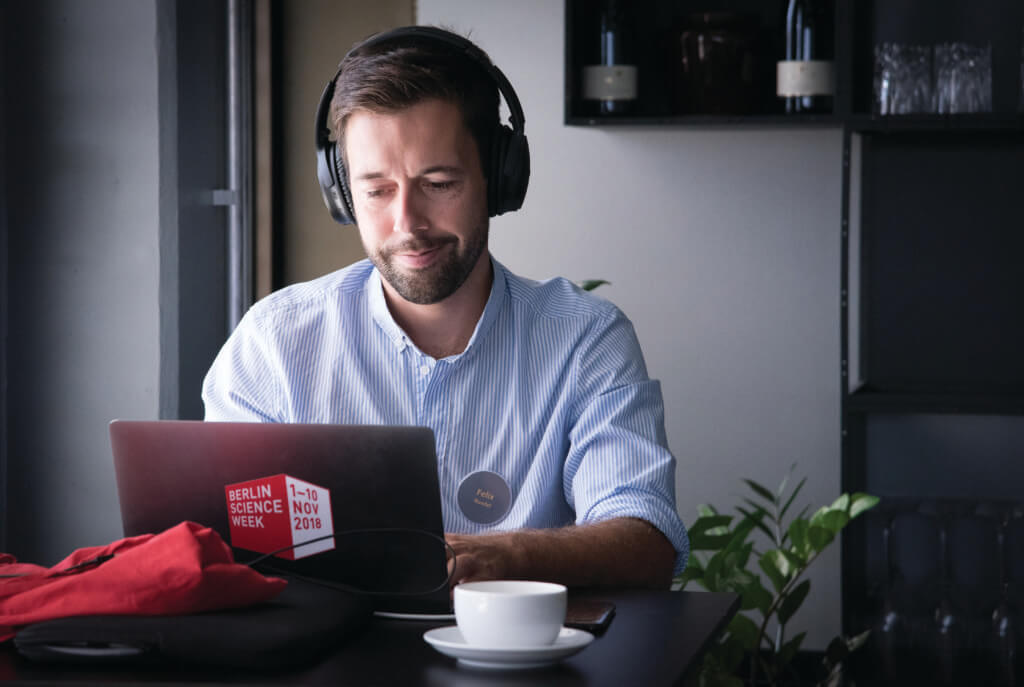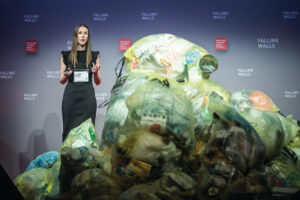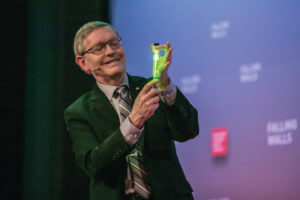
“Falling Walls” may initially seem an odd choice for a conference name, but it makes perfect sense as soon as you hear how the conference was conceived. “The fall of the Berlin wall, Nov. 9, 1989 [was a] powerful historical moment of the world coming together, the end of the Cold War, the celebration of a peaceful revolution, and the reunification of Germany,” Falling Walls Foundation’s Felix Rundel told Convene via email. “Falling Walls builds on this historical moment and metaphor.”
Held in Berlin on Nov. 8–9 each year since 2009 — the 20th anniversary of the fall of the wall — the conference measures up to that momentous event in its ambitious scope and mission. “We invite our speakers and audience to discuss the question: Which are the next walls to fall — and how will this change our lives?” said Rundel, who is the foundation’s head of programs and international development. “The topics range from scientific breakthroughs that won and will win Nobel Prizes, across revolutionary technologies and their societal benefits, to the collaborative solutions that will be needed in order to tackle the world’s thorniest problems, such as climate change, global epidemics, or the ethics of disruptive technologies like gene editing or AI.”
We asked Rundel to share how Falling Walls fosters discussion on research and innovation and promotes the latest scientific findings among a broad audience from all parts of society — science, business, politics, and the arts.
Please tell us about Falling Walls’ “breakthrough” approach and your program format.

Falling Walls Conference 2017, Berlin. (Photo/Florian Gaertner, photothek.net, Falling Walls)
[Our] 15-minute keynote talks form the backbone of the conference, [so] curation is key. We invite scientists, scholars, thinkers, and artists who combine the highest reputation in their field with the charisma and enthusiasm to really impress the audience during their talks and highlight the urgency and importance of their relevant topic. Thus, the selection process is very rigid and depends on our international network for recommendations and references, as well as our distinguished board of trustees, headed by Prof. Jürgen Mlynek. Once a speaker is confirmed, we work towards the talks in a continuous exchange. The goal is for each talk to inform and inspire — but also show up surprising facts and connections that people weren’t aware of. We use a lot of creative interventions, experiments, and audience interactions to create memorable experiences during the talks that illustrate key concepts that may sometimes be difficult to grasp. Also, we have our mime, Klaus [Franz], who acts as our creative timekeeper and ends the talks strictly after 15 minutes. He is a cult figure among our audience by now.
After each session of four keynotes, the exchange on the keynote topics is continued simultaneously on four panel stages called Falling Walls Forum. The Forum is in the middle of the area where people eat, drink, and chat during the breaks and it really brings a marketplace feel to the breaks. These sessions are 30 minutes long and we match each speaker with a science journalist as moderator and add a co-panelist who represents an entirely different angle on the topic. That way, we try to widen the discussion and bridge several fields — for example, an AI technologist with an ethics expert or a nano-materials researcher with an industry representative. The entire panel practically takes place on eye level amidst the audience, which is invited to ask any questions they might have. This is very important to us in terms of providing direct access to our speakers and encouraging the exchange between the audience — who are all experts in one way or another — and our speakers. In order to have discussions while everyone is chatting and eating all around, we use a “silent disco” format for the panel discussions: Every participant has headphones to connect to the relevant channel of a panel discussion and questions are asked using microphones.
Another way of enabling a different mode of exchange is in breakout sessions that take place on the MS Falling Walls, a ship docked right next to the conference venue on the Spree River. The breakout sessions are hosted by partners like X (formerly Google X) or Bayer Foundations, bring together some 20 participants in each session, and topics range from moon-shot thinking to impact entrepreneurship. These sessions are hands-on, collaborative, and often provide a great way to network on a shared-interest basis.
How do you foster networking?
Now this is the cue for our main networking tool — it’s called brain dating (or Falling Walls Connect). Instead of having the usual business-networking atmosphere you find at conferences, we moved on to a peer-learning philosophy in how we facilitate connections at Falling Walls. The inspiration to do that came from our friends and partners from Montréal, e-180, the inventors of brain dates. They provide a platform for participants to book 30-minute meetings, so-called “brain dates,” based on learning interests. So as a participant, I am asked to put forward things I could contribute to the conference. That way, other people can find me on that basis and book a meeting, or even a group meeting. The online platform that does that, also matches participants with contributions they might find useful and interesting.
When at the conference, participants meet at our brain-dating lounges. They find a check-in counter staffed with trained matchmakers who show them their date. But more than that, the matchmakers and the entire brain-dating lounge create an atmosphere that encourages participants to be open, personal, and outgoing. We also use ice-breaker cards handed out to participants to kick-start conversations. In any of the brain-dating lounges you will find this fantastic energy and the feeling that it’s okay to talk to anyone, from a young successful researcher to the CEO of a global firm.
From the brain-dating lounge to the Forum stage and the lecture hall, we always try to create spaces and atmospheres that benefit and encourage certain interactions and experiences. For that, we use the tools and perspectives of meeting design. Each year, academic institutions around the world are invited to host a Falling Walls Lab to showcase the quality, diversity, and passion of their region’s most innovative minds, according to your website.
How does this feed your mission and intersect with the Falling Walls annual conference?
The Falling Walls Lab is our global program for young and emerging scientists, entrepreneurs, and innovators of all kinds. At each Falling Walls Lab, a number of participants are invited to pitch their “breakthrough idea” in three minutes to their peers, guests, and a high-level jury. The jury later picks a winner, but in fact, everyone wins. The participants get to meet like-minded people who are just as talented, enthusiastic, and driven as themselves and they get a chance to expose their work or project to leaders from academia, policy, media, and business.
For many, this is a life-changing experience, especially since the winners of each regional Lab are invited to the Finale in Berlin, on the eve of the Falling Walls Conference. We currently are running 84 such events in more than 60 countries with our local hosting institutions, usually local universities. One hundred winners from these global events will travel to Berlin, pitch their breakthrough projects, and join the other participants at the conference. The winner of the Finale even gets to speak on the grand stage on Nov. 9 — and, in turn, receives a lot of media attention and cooperation offers. The amount of international exchange happening at the Falling Walls Lab is extraordinary. Lab participants are also the power users of our brain-dating platform.
I also understand from your website that the Falling Walls Venture showcases the most promising research-based start-ups from around the world, nominated by universities and research institutions. Twenty companies are selected to present their ideas in Berlin. Could you tell us more about that initiative — and Falling Walls Circle?
Falling Walls Venture shares a similar fast-paced pitch format, but its target group is international, science-based startups. In this case, the jury selects for the best business model, and the societal impact achieved by the company. It also takes place on Nov. 8, in close proximity to the Falling Walls Lab.
Falling Walls Circle is our gathering for high-level science strategists, C-level representatives of companies that do a lot of R&D, science media leaders, and science policy-makers. Each year, we provide a different framework to discuss meta-level questions on science, business, and society. This year’s topic is “Human Genius in the Age of Artificial Intelligence,” and it will feature input from renowned AI experts as well as lots of space for facilitated discussions.
How do you enable cross-disciplinary collaboration at Falling Walls? What do you think is the benefit of bringing people together from different disciplines to address a particular issue?

Jennifer Lavers’ 2017 show and tell on ocean plastics pollution. (Photo/Florian Gaertner, photothek.net, Falling Walls)
To us as conference hosts, enabling cross-disciplinary collaboration means that we need a wide range of people with different backgrounds and expertise in the room — ranging from basic research, industry, and technology, to the humanities and arts. Our ambition is to host an audience that can help each other take on different perspectives and inspire each other to do things differently. Then we try to create an atmosphere in which people feel encouraged to connect, not just on a professional level, but also beyond that. The goal is to create a setting where participants can best find shared interests, but it obviously takes more in order to get to the point of cooperation.
Serendipity is an element often quoted when we hear about spontaneous fruitful meetings that led to later cooperation — as in, “I met this guy in the coffee line and it turned out he had the answer to the question I was stuck on for weeks.” Of course, gathering interdisciplinary groups also requires a different approach to how content is presented. Our conference language is English, that’s clear, but in order for everyone to be able to join the conversation, keynote talks and conversations need to stay within a certain level of complexity — you could call it a “challenging, but lay-friendly” style.
In scientific research specifically, but also in the private sector, we see a trend towards highly interdisciplinary teams to tackle particular problems. The large-scale brain-research projects in the U.S. and Europe are an example. There is a growing insight that many of the complex challenges we’re facing today can only be tackled by [bringing together] experts from lots of backgrounds and perspectives — and more than that, by joining efforts between science, business, policy, media, and society/consumers. That is one of the messages we try to highlight with our speakers when it comes to topics like climate change, coral reef decline, ethical guidelines for gene editing, and more.
Do you intentionally bring different disciplines together to discuss to ensure you have a good mix or is it entirely up to the participants to decide how to spend their time at the conference?
Participants can generally decide on how they spend their time, but we do provide a program that makes sure that to some degree, everyone shares the same experiences and knowledge. During our 16 keynotes, all conference participants are listening to the speakers at the same time. No one leaves the auditorium, no one works on their computers, or texts. It’s a shared experience for everyone that later program parts build upon. We do intentionally curate the Forum stage panel discussions so that you can find this interdisciplinary element, and our general message to participants is: “Talk to your neighbor, she might just be the expert or collaborator you were looking for.”
In all our programs, from Falling Walls Lab to Venture and Circle, we do try to curate the mix of participants as much as possible in terms of international representation and diversity of sectors and fields. By doing that, we try to break up the traditional ways of field-specific conferences. Over the years, we’ve found out that this specific audience mix is something our participants very much appreciate.
You draw participants from 80 different countries. How important is this global makeup to the outcomes you seek from the event? Has it become more or less challenging to attract attendees from around the world?
It has always been our ambition to gather participants from all continents in order to create conferences and a community that represents forward-thinking from all over the globe. Most of the “next walls to fall” cannot be tackled by individual nation states or merely “Western” or “Eastern” alliances. Therefore, any discussion should aim at including as many diverse voices as possible. Since our international network has grown a lot over the last 10 years, and Falling Walls has also gained in reputation, it has become easier to attract international attendees. The wide spread of the Falling Walls Lab events has also been an important factor in spreading our message of international dialogue on science and innovation for furthering sustainability and human well-being.
Can you provide a specific example of how participants from different countries and different disciplines have collaborated to work on a pressing issue/particular challenge of our time as a result of participating in Falling Walls?

Speaker William Moerner was awarded the 2014 Nobel Prize in Chemistry. (Photo/Florian Gaertner, photothek.net, Falling Walls)
Just the other day, I heard from a very successful German robotics researcher who was a panelist at Falling Walls in 2017 and just started a large, new research center in Munich. He had a conversation with one of our young scientists participating in the Falling Walls Lab. The young researcher is from Sudan and gave a winning talk on combining artificial intelligence and robotics to help people with disabilities. The two of them met during one of the conference breaks and will start working together this fall, because the young researcher was offered a position at the robotics center in Munich. This is just one small example of successful outcomes. In one of the earlier conferences, a leading German psychologist, Tania Singer (Max Planck Institute), and Olafur Eliasson, the superstar artist with Danish-Icelandic roots, started a collaboration on the theme of empathy which lasted for several years and had various outputs.
Is there anything you’d like to add?
As conference makers, we are always curious to find out how we can improve our participants’ experience and create better value for them. Often we look to other events and conferences in other sectors and try to find out which of their solutions could work for us. What I would wish for is more international platforms for this kind of exchange in our own field, more shared perspectives — and more cooperation between event organizers on an international level.

